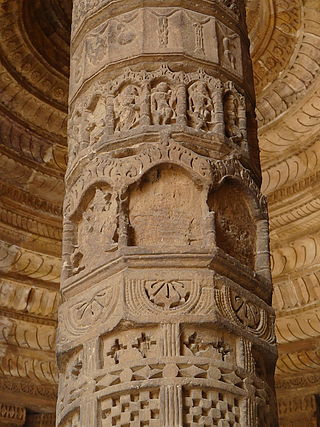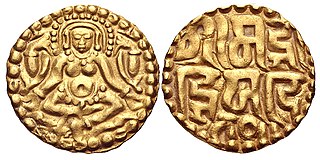
Prithviraja III, popularly known as Prithviraj Chauhan or Rai Pithora, was a king from the Chauhan (Chahamana) dynasty who ruled the territory of Sapadalaksha, with his capital at Ajmer in present-day Rajasthan. Ascending the throne as a minor in 1177 CE, Prithviraj inherited a kingdom which stretched from Thanesar in the north to Jahazpur (Mewar) in the south, which he aimed to expand by military actions against neighbouring kingdoms, most notably defeating the Chandelas.

The Gahadavala dynasty also Gahadavalas of Kannauj was a Rajput dynasty that ruled parts of the present-day Indian states of Uttar Pradesh and Bihar, during 11th and 12th centuries. Their capital was located at Banaras in the Gangetic plains, and for a brief period, they also controlled Kannauj.
Jaya-chandra was a king from the Gahadavala dynasty of northern India. He is also known as Jayachchandra in inscriptions, and Jaichand in vernacular legends. He ruled the Antarvedi country in the Gangetic plains, including the important cities of Kannauj and Varanasi. His territory included much of the present-day eastern Uttar Pradesh and some parts of western Bihar. The last powerful king of his dynasty, he was defeated and killed in 1194 CE, in a battle near Yamuna against a Ghurid army led by Muhammad of Ghor.

The Prithviraj Raso is a Braj language epic poem about the life of Prithviraj Chauhan. It is attributed to Chand Bardai, who according to the text, was a court poet of the king.
Bhabhanpura is a village on the outskirts of Varanasi city, located 7 km away from the heart of the city. Total population of the village is 2,992.

The Tomara dynasty ruled parts of present-day Delhi and Haryana in India during 8th-12th century. Their rule over this region is attested to by multiple inscriptions and coins. In addition, much of the information about them comes from medieval bardic legends. They belonged to the Tomar clan of the Rajputs.

Harakeli Nataka is a Sanskrit drama written by the Chahamana (Chauhan) king Vigraharaja IV alias Visaladeva, who ruled from 1150 to 1164 CE. This drama is based on Kiratarjuniya of writer Bharavi.The play is also called Lalita Vigraharaja Nataka.

The Chahamanas of Shakambhari, colloquially known as the Chauhans of Sambhar or Chauhans of Ajmer, were an Indian dynasty that ruled parts of the present-day Rajasthan and neighbouring areas in India, between the 6th and 12th centuries. The territory ruled by them was known as Sapadalaksha. They were the most prominent ruling family of the Chahamana (Chauhan) Rajput clan.

The Kalachuris of Tripuri, also known the Kalachuris of Chedi, ruled parts of central India during 7th to 13th centuries. They are also known as the Later Kalachuris to distinguish them from their earlier namesakes, especially the Kalachuris of Mahishmati. Their core territory included the historical Chedi region, and their capital was located at Tripuri.

The 11th century Paramara king Bhoja ruled from his capital at Dhara. The period of his reign is dated approximately 1010 CE to 1055 CE, although some historians believe that he ascended the throne before 1010 CE. Bhoja inherited a kingdom centered around the Malwa region, and made several attempts to expand it varying results. He managed to annex territories as far as northern parts of Konkan, but these territorial gains were short-lived. He fought wars against several of his neighbours, including the Chaulukyas of Gujarat, the Chalukyas of Lata, the Chalukyas of Kalyani, the Chandelas of Jejakabhukti, the Kachchhapaghatas of Gwalior, the Chahamanas of Shakambhari, the Chahamanas of Naddula, and the Kalachuris of Tripuri. He also conflicted with Gaznavid Turk Invaders, Mahmud's desecration of the Somnath temple in Gujarat motivated Bhoja to lead an army against him, however after Somnath raid, Mahmud Gazhnavi chose a more dangerous route via Sindh, to avoid facing the invading powerful armies of Bhoja.
Someshvara was an Indian king belonging to the Chahamana dynasty and ruled parts of present-day Rajasthan in north-western India. He was brought up at the Chaulukya court in Gujarat by his maternal relatives. After death of Prithviraja II, the Chahamana ministers brought him to the capital Ajmer and appointed him as the new king. He is said to have commissioned several Shiva temples in Ajmer, and is best known as the father of Prithviraja III.

Prithvirāja II was an Indian king from the Chahamana dynasty. He ruled parts of north-western India, including present-day Rajasthan. He is also known by other names, including Prithvi-bhatta, Prithvi-deva and Pethad-deva.

Vigraharāja IV, also known as and also Visaladev was a king from the Chahamana (Chauhan) dynasty in north-western India, and is generally considered as one of the greatest rulers of the dynasty. He turned the Chahamana kingdom into an empire by subduing the neighbouring kingdoms of Chaulukya, Naddula, and Tomara kingdoms. He also repulsed Muslim invasions, from the Ghaznavid ruler Bahram Shah and defeated Khusrau Shah in Vigraharaja IV's first war against the Muslims.
Vigraharāja II was a king belonging to the Shakambhari Chahamana dynasty. He ruled the Sapadalaksha country, which included parts of present-day Rajasthan in north-western India.
Chamundaraja was an Indian king belonging to the Shakambhari Chahamana dynasty. He ruled the Sapadalaksha country, which included parts of present-day Rajasthan in north-western India.
Chandradeva, also known as Chandraditya, was an Indian king from the Gahadavala dynasty. He ruled the Antarvedi country in present-day Uttar Pradesh, including Kanyakubja and Varanasi.
Madana-pala, also known as Madana-chandra, was an Indian king from the Gahadavala dynasty. He ruled the Antarvedi country in present-day Uttar Pradesh, including Kanyakubja and Varanasi.

Govindachandra was an Indian king from the Gahadavala dynasty. He ruled the Antarvedi country in present-day Uttar Pradesh, including the major cities of Kanyakubja and Varanasi.
Harishchandra was an Indian king from the Gahadavala dynasty. The last known king from the family's imperial branch, he probably ruled a part of his ancestral kingdom in present-day Uttar Pradesh.
The Vishnu Hari inscription is the name given to a Sanskrit language inscription found in the Uttar Pradesh state of India. It records the construction of a temple by Anayachandra, a feudatory of the king named Govindachandra, and also contains a eulogy of Anayachandra's dynasty. Its date portion is missing, and its authenticity has been a matter of controversy.









